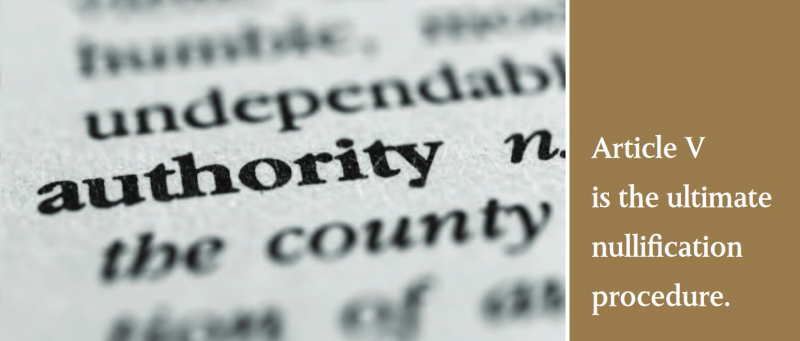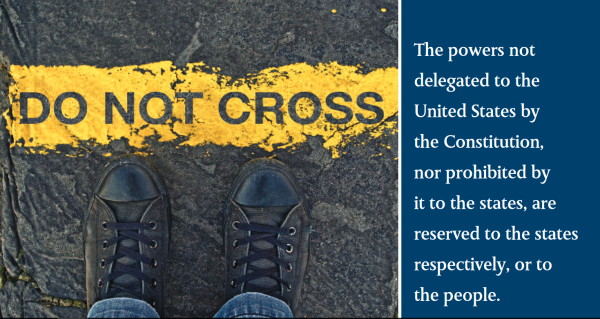Article 16 - Implement Tenth Amendment
The Article V Solution — The Way to Implement the Tenth Amendment
Rita Dunaway, Esq., National Legislative Strategist for the Convention of States Project
It’s the elephant in the room. The Tenth Amendment boldly declares:
“The powers not delegated to the United States by the Constitution, nor prohibited by it to the states, are reserved to the states respectively, or to the people.”
But if the daily news is any indication, there is no subject exempt from federal power. Through its power of the purse, which is virtually unlimited under the modern interpretation, Congress can impact, influence, or coerce behavior in nearly every aspect of life.
The question, then, that holds the key to unlocking our constitutional quandary, is this: How do states protect their reserved powers under the Tenth Amendment?
On a piecemeal basis, states can certainly challenge federal actions through lawsuits, arguing that the federal government lacks constitutional authority to act in a particular area. But what if the court, as it is wont to do, “interprets” the Constitution as providing the disputed authority? What then?
In their frustration and disbelief over the growing extent of federal abuses of power (and the refusal of our Supreme Court to correct them), some conservatives argue that states should engage in “nullification,” whereby the states simply refuse to comply with federal laws they deem unconstitutional.
While there are some, less dramatic forms of nullification that are perfectly appropriate and constitutional—such as
states refusing to accept federal funds that come attached to federal requirements—this state-by-state, ad hoc review of federal law is fraught with legal and practical pitfalls.
First of all, which state officer, institution, or individual decides whether a federal action is authorized under the Constitution? Is it the state supreme court, the legislature, the attorney general—or can any individual make the determination? After all, the Tenth Amendment reserves powers to individuals as well as to states.
Secondly, how can a state enforce its nullification of a federal law? For instance, if a state decides that the Affordable Care Act’s individual man-date is unconstitutional, how can it protect its citizens against the “tax” that will be levied against them if they fail to comply? It’s difficult to envision an effective nullification enforcement method that doesn’t end, at some point, with armed conflict.
But for true conservatives whose goal is to conserve the original design of our federal system, the far more fundamental problem with this type of in-your-face nullification is the fact that it was not the Founders’ plan.
Article VI tells us that the Constitution, and federal laws passed pursuant to it, is the “supreme law of the land.” Under Article III, the United States Supreme Court is considered to be the final interpreter of the Constitution. While some claim that this was not the Founders’ intention, historical records such as Alexander Hamilton’s Federalist 78 demonstrate it was, in fact, the judiciary that they intended to assess the constitutionality of legislative acts.
And then we have the Tenth Amendment itself. It establishes a principle, but it does not establish a remedy or process for protecting the reserved powers from federal intrusion.
That missing process is found in Article V. Faced with a federal government acting beyond the scope of its legitimate powers—and a Supreme Court that adopts erroneous interpretations of the Constitution to justify the federal over-reach—the states’ constitutional remedy is to amend the Constitution to clarify the meaning of the clauses that have been perverted. In this way, the states can assert their authority to close the loopholes the Supreme Court has opened.
You don’t have to take my word for it.
In an 1830 letter to Edward Everett, James Madison wrote:
“Should the provisions of the Constitution as here reviewed be found not to secure the Govt. & rights of the States agst. usurpations & abuses on the part of the U.S. the final resort within the purview of the Constn. lies in an amendment of the Constn. according to a process applicable by the States.”
In other words, Article V is the ultimate nullification procedure. For states that have the will to stand up and assert their Tenth Amendment rights, they can do so by applying for an Article V convention to propose amendments that restrain federal power.
Originally published on TheBlaze.com



